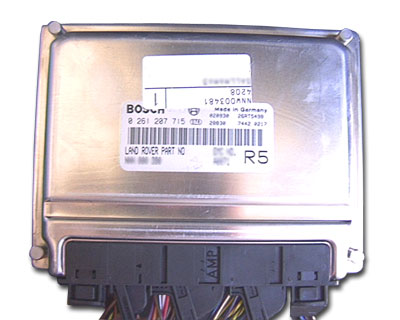 BOSCH ME7.2 - System Overview
BOSCH ME7.2 - System Overview BOSCH ME7.2 - System Overview BOSCH ME7.2 - System Overview |
| Quite a sophisticated and modern Petrol Engine management system ECU. Manufactured by Bosch, and the latest in a long line of variations of the well known Motronic name, this ECU is also referred to in BMW terminology as DME Digital Motor Electronics. Being a flash based ECU with a huge memory the entire code that controls itís operationally and functionality including its self diagnostic capability is determined by whatever version of software is programmed into it. Although Used extensively in many BMW models and some Porsches the system is also fitted into the petrol versions of the L322 Range Rover that are fitted with the BMW 4.4 Litre V8 engine, introduced in 2002 and was replaced in 2005 with a Denso unit employed by Ford who had purchased Land Rover from BMW to accompany their own Jaguar based engine. It is a modern enough ECU to fully support the limited degree of information and fault codes provided for by enforced OBDII compliance, but of course there many more fault codes, functions and features that this module gives access to beyond simple OBDII compatibility, including security link learning and re synchronization. |
 SM046 - BOSCH ME7.2 - System Help file SM046 - BOSCH ME7.2 - System Help file |
| Version 1.27 |
 BOSCH ME7.2 - Known Fitments BOSCH ME7.2 - Known Fitments |
||||||||||||||||||||||||||||||||||||||||||||
Vehicle makes, models and variants known or believed to be using this vehicle system, required diagnostic lead and degree of known compatibility.
|
 BOSCH ME7.2 - Physical Details BOSCH ME7.2 - Physical Details |
 |
 BOSCH EDC TD4 - Pin Outs BOSCH EDC TD4 - Pin Outs |
||||||||||||||||||||||||||||||||||||||||||||||||||||||||||||||||||||||||||||||||||||||||||||||||||||||||||||||||||||||||||||||||||||||||||||||||||||||||||||||||||||||||||||||||||||||||||||||||||||||||||||||||||||||||||||||||||||||||||||||||||||||||||||||||||||||||||||||||
Details of the pin usage for the ECU connector(s).
|
 SM046 - BOSCH ME7.2 - Diagnostic Capabilities (Read Fault Codes) SM046 - BOSCH ME7.2 - Diagnostic Capabilities (Read Fault Codes) |
| Reads the fault code memory. The ECU can self detect up to 47 different problems with itself, its wiring and its associated sensors, storing the respective code if it detects any malfunction or reading outside of pre defined acceptable limits. Not all stored faults may cause the fault warning lamp to illuminate. |
 SM046 - BOSCH ME7.2 - Diagnostic Capabilities (Clear Fault Codes) SM046 - BOSCH ME7.2 - Diagnostic Capabilities (Clear Fault Codes) |
| Clears the fault code memory. |
 SM046 - BOSCH ME7.2 - Diagnostic Capabilities (Settings) SM046 - BOSCH ME7.2 - Diagnostic Capabilities (Settings) |
Values, configuration settings, and other stored information which can be read from the ECU, edited and then rewritten back. Read settings can also be stored as a standard HTML page for reference. These pages can then later be re loaded and re written back to the ECU. Please note that some values may be read only due to the fact that they are supplied from the ECUís ROM or are internally calculated.
|
 SM046 - BOSCH ME7.2 - Diagnostic Capabilities (Inputs) SM046 - BOSCH ME7.2 - Diagnostic Capabilities (Inputs) |
| Realtime live display of the information the electronic control unit of the selected vehicle system is currently deriving from its input sensors. GENERAL PAGE 1
GENERAL PAGE 2
GENERAL PAGE 3
GENERAL PAGE 4
GENERAL PAGE 5
SWITCHES
The cruise switches display shows the status of the cruise control switches on the steering wheel.
|
 SM046 - BOSCH ME7.2 - Diagnostic Capabilities (Outputs) SM046 - BOSCH ME7.2 - Diagnostic Capabilities (Outputs) |
|
 SM046 - BOSCH ME7.2 - Diagnostic Capabilities (Other) SM046 - BOSCH ME7.2 - Diagnostic Capabilities (Other) |
|